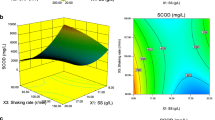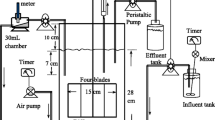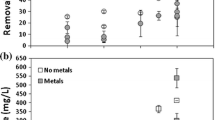Abstract
The optimization of operation parameters is a key consideration to minimize nitrous oxide (N2O) emissions in biological nitrogen removal processes. So far, different parameters have only been investigated individually, making it difficult to compare their specific effects and combined influences. In this study, we applied the Plackett–Burman (PB) multifactorial experimental design and response surface methodology (RSM) analysis to find the optimized condition for the mitigation of N2O release in a nitrifying granular sludge system. Seven parameters (temperature, pH, feeding strategy, C/N ratio, aeration rate, Cu2+ concentration, and aeration mode) were tested in parallel. Five of them (other than chemical oxygen demand/nitrogen (C/N) ratio and Cu2+ concentration) were selected as influential factors. Since the type of feeding strategies and aeration modes cannot be quantified, continuous feed strategy and anoxic/oxic aeration mode were applied for the following study. Influences of temperature, pH, and aeration rate on N2O emissions were tested with RSM analysis to further investigate the mutual interactions among the parameters and to identify the optimal values that would minimize N2O release. Results showed the minimum emission value could be obtained under the temperature of 22.3 °C, pH of 7.1 and aeration rate of 0.20 m3/h. Predicted results were then verified by subsequent validation experiments. The estimated N2O emission value of each design by RSM was also observed in good relationships with experimental result.



Similar content being viewed by others
References
Abdel-Fattah YR, Saeed HM, Gohar YM, El-Baz MA (2005) Improved production of Pseudomonas aeruginosa uricase by optimization of process parameters through statistical experimental designs. Process Biochem 40:1707–1714
Ahn JH, Kim S, Park H, Rahm B, Pagilla K, Chandran K (2010) N2O emissions from activated sludge processes, 2008–2009: results of a national monitoring survey in the United States. Environ Sci Technol 44:4505–4511
Ahn JH, Kwan T, Chandran K (2011) Comparison of partial and full nitrification processes applied for treating high-strength nitrogen wastewaters: microbial ecology through nitrous oxide production. Environ Sci Technol 45:2734–2740
Ahuja S, Ferreira G, Moreira A (2004) Application of Plackett‐Burman design and response surface methodology to achieve exponential growth for aggregated shipworm bacterium. Biotechnol Bioeng 85:666–675
APHA (2005) Standard methods for the examination of water and wastewater, 21st edn. American Public Health Association, Washington, DC
Benoit M, Garnier J, Billen G (2015) Temperature dependence of nitrous oxide production of a luvisolic soil in batch experiments. Process Biochem 50:79–85
Castro-Barros CM, Daelman M, Mampaey K, van Loosdrecht M, Volcke E (2015) Effect of aeration regime on N2O emission from partial nitritation-anammox in a full-scale granular sludge reactor. Water Res 68:793–803
Chandran K, Stein LY, Klotz MG, van Loosdrecht MC (2011) Nitrous oxide production by lithotrophic ammonia-oxidizing bacteria and implications for engineered nitrogen-removal systems. Biochem Soc Trans 39:1832
Chen Y, Wang D, Zhu X, Zheng X, Feng L (2012) Long-term effects of copper nanoparticles on wastewater biological nutrient removal and N2O generation in the activated sludge process. Environ Sci Technol 46:12452–12458
Chung Y, Chung M (2000) BNP test to evaluate the influence of C/N ratio on N2O production inbiological denitrification. Water Sci Technol 42:23–27
Colliver B, Stephenson T (2000) Production of nitrogen oxide and dinitrogen oxide by autotrophic nitrifiers. Biotechnol Adv 18:219–232
Domingo-Félez C, Mutlu AG, Jensen MM, Smets BF (2014) Aeration strategies to mitigate nitrous oxide emissions from single-stage nitritation/anammox reactors. Environ Sci Technol 48:8679–8687
Gejlsbjerg B, Frette L, Westermann P (1998) Dynamics of N2O production from activated sludge. Water Res 32:2113–2121
Granger J, Ward BB (2003) Accumulation of nitrogen oxides in copper-limited cultures of denitrifying bacteria. Limnol Oceanogr 48:313–318
Hanaki K, Hong Z, Matsuo T (1992) Production of nitrous oxide gas during denitrification of wastewater. Water Sci Technol 26:1027–1036
Holtan-Hartwig L, Dörsch P, Bakken L (2002) Low temperature control of soil denitrifying communities: kinetics of N2O production and reduction. Soil Biol Biochem 34:1797–1806
Hu Z, Lee JW, Chandran K, Kim S, Khanal SK (2012) Nitrous oxide (N2O) emission from aquaculture: a review. Environ Sci Technol 46:6470–6480
IPCC (2006) 2006 IPCC guidelines for national greenhouse gas inventories. IGES, Japan
Kampschreur MJ, Tan NC, Kleerebezem R, Picioreanu C, Jetten MS, Loosdrecht MC (2007) Effect of dynamic process conditions on nitrogen oxides emission from a nitrifying culture. Environ Sci Technol 42:429–435
Kampschreur MJ, Temmink H, Kleerebezem R, Jetten MS, van Loosdrecht MC (2009) Nitrous oxide emission during wastewater treatment. Water Res 43:4093–4103
Karl TR et al (2015) Possible artifacts of data biases in the recent global surface warming hiatus. Science 348:1469–1472
Law Y, Lant P, Yuan Z (2011) The effect of pH on N2O production under aerobic conditions in a partial nitritation system. Water Res 45:5934–5944
Law Y, Ni B-J, Lant P, Yuan Z (2012a) N2O production rate of an enriched ammonia-oxidising bacteria culture exponentially correlates to its ammonia oxidation rate. Water Res 46:3409–3419
Law Y, Ye L, Pan Y, Yuan Z (2012b) Nitrous oxide emissions from wastewater treatment processes. Philos Trans R Soc B Biol Sci 367:1265–1277
Law Y, Lant P, Yuan Z (2013) The confounding effect of nitrite on N2O production by an enriched ammonia-oxidizing culture. Environ Sci Technol 47:7186–7194
Lee W, Kang S, Shin H (2003) Sludge characteristics and their contribution to microfiltration in submerged membrane bioreactors. J Membr Sci 216:217–227
Lochmatter S, Holliger C (2014) Optimization of operation conditions for the startup of aerobic granular sludge reactors biologically removing carbon, nitrogen, and phosphorous. Water Res 59:58–70
Ni B-J, Ye L, Law Y, Byers C, Yuan Z (2013) Mathematical modeling of nitrous oxide (N2O) emissions from full-scale wastewater treatment plants. Environ Sci Technol 47:7795–7803
Nicolau A, Martins MJ, Mota M, Lima N (2005) Effect of copper in the protistan community of activated sludge. Chemosphere 58:605–614
Peng L, Ni B-J, Erler D, Ye L, Yuan Z (2014) The effect of dissolved oxygen on N2O production by ammonia-oxidizing bacteria in an enriched nitrifying sludge. Water Res 66:12–21
Peng L, Ni B-J, Ye L, Yuan Z (2015) The combined effect of dissolved oxygen and nitrite on N2O production by ammonia oxidizing bacteria in an enriched nitrifying sludge. Water Res 73:29–36
Puri S, Beg QK, Gupta R (2002) Optimization of alkaline protease production from Bacillus sp. by response surface methodology. Curr Microbiol 44:286–290
Ravishankara A, Daniel JS, Portmann RW (2009) Nitrous oxide (N2O): the dominant ozone-depleting substance emitted in the 21st century. Science 326:123–125
Reddy L, Wee Y-J, Yun J-S, Ryu H-W (2008) Optimization of alkaline protease production by batch culture of Bacillus sp. RKY3 through Plackett–Burman and response surface methodological approaches. Bioresour Technol 99:2242–2249
Richardson D, Felgate H, Watmough N, Thomson A, Baggs E (2009) Mitigating release of the potent greenhouse gas N2O from the nitrogen cycle–could enzymic regulation hold the key? Trends Biotechnol 27:388–397
Rodriguez-Caballero A, Aymerich I, Marques R, Poch M, Pijuan M (2015) Minimizing N2O emissions and carbon footprint on a full-scale activated sludge sequencing batch reactor. Water Res 71:1–10
Schreiber F, Loeffler B, Polerecky L, Kuypers MM, De Beer D (2009) Mechanisms of transient nitric oxide and nitrous oxide production in a complex biofilm. ISMEJ 3:1301–1313
Shi Y-J, Wang X-H, Yu H-B, Xie H-J, Teng S-X, Sun X-F, Tian B-H, Wang S-G (2011) Aerobic granulation for nitrogen removal via nitrite in a sequencing batch reactor and the emission of nitrous oxide. Bioresour Technol 102:2536–2541
Shi L, Wei D, Ngo HH, Guo W, Du B, Wei Q (2015) Application of anaerobic granular sludge for competitive biosorption of methylene blue and Pb(II): Fluorescence and response surface methodology. Bioresour Technol 194:297–304
Suzuki I, Dular U, Kwok S (1974) Ammonia or ammonium ion as substrate for oxidation by Nitrosomonas europaea cells and extracts. J Bacteriol 120:556–558
Swamy GJ, Sangamithra A, Chandrasekar V (2014) Response surface modeling and process optimization of aqueous extraction of natural pigments from Beta vulgaris using Box–Behnken design of experiments. Dyes Pigments 111:64–74
Sweetapple C, Fu G, Butler D (2014) Identifying sensitive sources and key control handles for the reduction of greenhouse gas emissions from wastewater treatment. Water Res 62:249–259
Tak B-y, Tak B-s, Kim Y-j, Park Y-j, Yoon Y-h, Min G-h (2015) Optimization of color and COD removal from livestock wastewater by electrocoagulation process: Application of Box–Behnken design (BBD). J Ind Eng Chem 28:307–315
Tallec G, Garnier J, Billen G, Gousailles M (2008) Nitrous oxide emissions from denitrifying activated sludge of urban wastewater treatment plants, under anoxia and low oxygenation. Bioresour Technol 99:2200–2209
Tsiaka T, Zoumpoulakis P, Sinanoglou VJ, Makris C, Heropoulos GA, Calokerinos AC (2015) Response surface methodology toward the optimization of high-energy carotenoid extraction from Aristeus antennatus shrimp. Anal Chim Acta 877:100–110
Wunderlin P, Mohn J, Joss A, Emmenegger L, Siegrist H (2012) Mechanisms of N2O production in biological wastewater treatment under nitrifying and denitrifying conditions. Water Res 46:1027–1037
Xiao Z, Liu P, Qin Jy XP (2007) Statistical optimization of medium components for enhanced acetoin production from molasses and soybean meal hydrolysate. Appl Microbiol Biotechnol 74:61–68
Xu J, Sheng G-P, Ma Y, Wang L-F, Yu H-Q (2013) Roles of extracellular polymeric substances (EPS) in the migration and removal of sulfamethazine in activated sludge system. Water Res 47:5298–5306
Yang Q, Liu X, Peng C, Wang S, Sun H, Peng Y (2009) N2O production during nitrogen removal via nitrite from domestic wastewater: main sources and control method. Environ Sci Technol 43:9400–9406
Yang S, Gao M-M, Liang S, Wang S-G, Wang X-H (2013) Effects of step-feed on long-term performances and N2O emissions of partial nitrifying granules. Bioresour Technol 143:682–685
Zhu X, Chen Y (2011) Reduction of N2O and NO generation in anaerobic−aerobic (low dissolved oxygen) biological wastewater treatment process by using sludge alkaline fermentation liquid. Environ Sci Technol 45:2137–2143
Zhu X, Chen Y, Chen H, Li X, Peng Y, Wang S (2013) Minimizing nitrous oxide in biological nutrient removal from municipal wastewater by controlling copper ion concentrations. Appl Microbiol Biotechnol 97:1325–1334
Acknowledgments
This work was supported by the National Natural Science Foundation of China (51108250), the Shandong Province Natural Science Foundation (ZR2015EM028), and the Fundamental Research Funds of Shandong University (2015JC025).
Author information
Authors and Affiliations
Corresponding author
Additional information
Responsible editor: Bingcai Pan
Rights and permissions
About this article
Cite this article
Liu, RT., Wang, XH., Zhang, Y. et al. Optimization of operation conditions for the mitigation of nitrous oxide (N2O) emissions from aerobic nitrifying granular sludge system. Environ Sci Pollut Res 23, 9518–9528 (2016). https://doi.org/10.1007/s11356-016-6178-3
Received:
Accepted:
Published:
Issue Date:
DOI: https://doi.org/10.1007/s11356-016-6178-3




